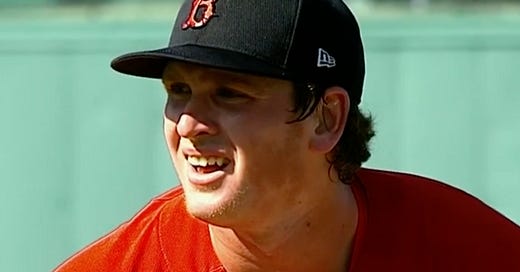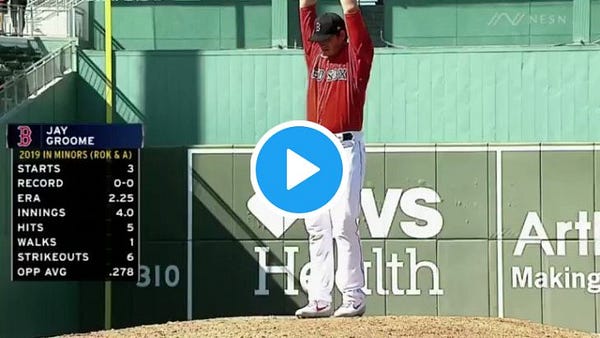Sunday Sox Notes: Franchy, Groome, X
Some Sox notes for your Sunday, in case that wasn't apparent from the title
We’re 17 days out from Opening Day and the rosters are getting smaller at Fort Myers. The Red Sox have moved some guys to the minor league camp, and we’re ready for the regulars to start ramping up to full games for the regular season.
Before we get to the notes, a quick reminder to check out the Sox Outsider Podcast. I had two episodes last week, the first with special guest Larry Olmsted, author of the new book Fans, about how fandom makes you healthier. It’s a fascinating book. The second was with my friend Matthew Trueblood. We talked about the Sox off-season and took a tour around the American League to get a sense of what the Red Sox are up against this season. Talking to Matthew always makes my mind work in interesting unexpected ways, and this discussion was no different. I definitely urge you to check it out. You can find all the different podcast providers who carry the Sox Outsider Podcast right here. More great guests coming up this week, so subscribe to the Sox Outsider Podcast right now!
To the notes!
Franchy
I think it was former Sox Outsider Podcast guest Christopher Smith of Mass Live who asked the question. At the end of Franchy Cordero’s press conference, Smith snuck in a great one, asking, in essence, how did Cordero drop his strikeout rate so drastically in 2020. A bit of refresher on this, which I covered in my article about the Benintendi trade at the time. Here’s what I wrote back then.
[Cordero’s] K% went from 44.4 percent to 35 percent, 35 percent again (in just nine games) in 2019, and then last season he knocked it down to 9.5 percent. That’s a massive drop […] he was doing a much better job of controlling the strike zone as well, swinging at strikes, hitting them hard (barreling pitches up), and not swinging at pitches outside the strike zone as much, all of which is impressive.
This is 2021, so there are good players who strike out a lot. Strike outs happens. But look at a list of the very best players. I pulled up the top 50 hitters by WAR on FanGraphs in 2018 and 2019, so 100 different player seasons. Just one of them contained a strikeout percentage over 30 percent. That was Aaron Judge’s 2018, and his strikeout percentage was 30.5 percent. Even though strikeouts are way up over recent decades and we see guys swing for the fences maybe more now than ever before, it’s still true that guys who strikeout a ton just aren’t very good hitters, generally speaking.
So, Smith asked Cordero, ‘how’d you stop striking out so much?" Cordero’s answer was fascinating. He said (through a translator),
Obviously it was a small sample size, but it’s something I’ve worked hard on in 2019, pitch recognition, trying to get deeper into counts, and just trying to make the pitcher work as hard as possible to get me out. That’s something I’ve made a point of emphasis and I’m coming into this camp as well because I understand it’s what’s going to help the team. Having more patience at the plate is something I’ve really worked hard on in the off-season and I’m looking forward to carrying it over here.
With the caveat that talking and playing are two very different things, that’s quite a quote! Teams have entire coaching positions in place to get this message across to players. I don’t think Cordero’s strikeout rate in 2021 is likely to be under 10 percent again, but if he’s under 20 percent he’s a whole different hitter. I mean, just look at the words he used. “Pitch recognition” and “patience at the plate” are two baseball buzzwords or phrases that you’re likely to hear out of the mouth of a team intern who recently graduated from Yale than a 26-year-old outfielder from the Dominican Republic. But that doesn’t make them meaningless. If Cordero is actually focusing on figuring out which pitches he’s seeing sooner and working to lay off pitches that aren’t strikes, that’s fantastic.
Players can be aware of problems in their approach but unable to solve them, so it’s not like his issues are fixed just because he knows what they are. But, the first step is to understand the problem, as they say. So the fact that his drop in strike out rate isn’t some blip, that Cordero is aware of the issue and is working to get better at it, is meaningful. There is star power in Cordero’s bat and if he’s able to accomplish this the Red Sox may have gotten themselves a steal.
Jay Groome
You may not remember Jay Groome. The Red Sox took him 12th overall in the first round of the 2016 draft. There was talk Groome would go first overall, but the Phillies opted to go with Mickey Moniak instead. Oops. Either way there was no chance Groome would be available when the Red Sox picked at 12, but due to his being a high school pitcher and some other off-the-field stuff, Groome fell down the draft board. The Red Sox couldn’t believe their good luck when he was available at pick 12, and they grabbed him.
In doing so, they turned over a massive amount of their draft budget in order to sign Groome, a high school pitcher, away from his college commitment. Things haven’t quite gone to plan since draft day. Groome has managed just 66 innings over the last five seasons. He’s had numerous injuries slow him up, including Tommy John surgery, which cost him parts of both the 2018 and 2019 seasons. Then COVID-19 happened and he didn’t pitch in 2020.
Groome is still just 22 years old, but he’s lost a massive amount of developmental time. So it was a great thing to turn on MLB.tv yesterday and see Groome standing on the Fenway South mound. If you’re curious to watch his inning, the Red Sox Stats twitter account kindly curated each pitch into a short two minute video, which you can see below.
The broadcast didn’t show it and you might not know it unless someone specifically mentioned it, but Groome was throwing pretty hard. Ian Cundall of Sox Prospects had the details.

I was impressed at how easily the velocity comes. Watch the video above, it does not look like he’s throwing that hard! The ball comes out of his hand so easily. Clearly there’s some rust there, but it’s a pretty good inning of work from Groome, especially considering the circumstances. Watch for a couple really nice curveballs in there, the pitch that in addition to his impressive velocity got him drafted.
It wasn’t all ice cream and unicorns made of ice cream though. Groome gave up a couple very hard hit balls, one which should’ve been a double into the gap, but the runner fell down rounding first, and the other which was a rocket right at third baseman Michael Chavis, another prospective extra base hit that wasn’t. He struck out a batter and walked a batter, though to my eye he was getting squeezed a bit by the home plate umpire. Regardless, it was great to see him standing on the mound and pitching. Just being there at a ball park, any ball park, pitching to a batter wearing a different uniform was a win.
It’s impossible to say what will become of Groome, but like Cordero, we’ll never know anything until he can get on the field and stay there for some reasonable period of time. That makes this a good start.
Groome will begin the year in the minors somewhere (Sox Prospects expects him to start the year in High-A Greenville) and with COVID-19 the minor league season will be delayed somewhat. Hopefully for everyone it’s not pushed back any further. Groome badly needs the work. There’s still a good starting pitcher in there somewhere, but with every passing minute it gets harder to see through the haze.
X
Xander Bogaerts started at DH for the second day in a row, his second spring training start since hurting his shoulder before games began. Bogaerts went 1-for-2, striking out in the first and doubling in the third. Both at-bats came against Braves starter Ian Anderson, one of the best pitching prospects in baseball. Before the game, Bogaerts declared himself ready for opening day, “right now.” That’s what you want to hear from your captain, right?






